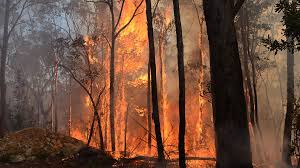Australia is experiencing more intense heatwaves and bush fire weather, more often than it was just decades ago, according to the latest State of the Climate report by the CSIRO and Bureau of Meteorology – a trend the two organisations say is largely attributable to the effects of global warming.
Released on Tuesday, the report finds that Australia’s climate has warmed by 0.9°C since 1910 – just outdoing the global mean temperature, which has risen by 0.85°C from 1880 to 2012.
The report says the duration, frequency and intensity of heatwaves have increased across large parts of Australia since 1950, with more heatwaves and fewer cool extremes. It also notes an increase in extreme fire weather and a longer fire season, across large parts of Australia since the 1970s.
Since 2001, says the report, “the number of extreme heat records in Australia has outnumbered extreme cool records by almost 3 to 1 for daytime maximum temperatures, and almost 5 to 1 for night-time minimum temperatures.”
“Some recent instances of extreme summer temperatures experienced around the world, including record- breaking summer temperatures in Australia over 2012–2013, are very unlikely to have been caused by natural variability alone.”
 The report predicts Australian temperatures will continue to increase, with more extremely hot days and fewer extremely cool days. By 2050, if greenhouse gas emissions continue to grow at the pace of the past decade, temperatures are expected to rise between 2.2-5°C above the 1980-99 average.
The report predicts Australian temperatures will continue to increase, with more extremely hot days and fewer extremely cool days. By 2050, if greenhouse gas emissions continue to grow at the pace of the past decade, temperatures are expected to rise between 2.2-5°C above the 1980-99 average.
“We expect there to be a continuation of (the) warming and probably an acceleration … in the decades to come,” said Penny Whetton, a climate projection expert at CSIRO.
The agencies also project that the number of extreme fire-weather will grow in southern and eastern Australia – by 10-50 per cent by 2050 in a low emissions scenario, and by 100-300 per cent in a high emissions scenario, compared with the climate of 1980 to 1999.
 Australia’s average rainfall, meanwhile, has slightly increased since 1900, with the largest increases in the northwest since 1970.
Australia’s average rainfall, meanwhile, has slightly increased since 1900, with the largest increases in the northwest since 1970.
But in the nation’s south-west, rainfall has declined since 1970, caused mainly by reduced winter rainfall. Autumn and early winter rainfall has also mostly been below average in the southeast since 1990.
The report predicts average rainfall in southern Australia will continue to decrease, while heavy rainfall will increase over most parts of Australia. Sea-level rise and ocean acidification are projected to continue.
“This report from the Government’s primary climate advisers should put an end to the reluctance of our political and business leaders to accept the risks and costs to Australia of inadequate climate action,”
“The government’s self-identified ‘primary advisers ’ on climate, BoM and CSIRO today clearly linked carbon emissions, climate change, fire and drought in stark contrast to their own reluctance to do so,” said Climate Institute CEO, John Connor, alluding to comments from Prime Minister Tony Abbott late last year that described any connection between climate change and bushfire risk as æcomplete hogwash.”
“This report …should put an end to the reluctance of our political and business leaders to accept the risks and costs to Australia of inadequate climate action,” Connor said.
But Bureau of Meteorology assistant director Peter May said it was beyond the report’s scope to advocate for political action, or to advise whether the government’s emissions reduction commitment goes far enough.
“(The report is) really about providing information for policymakers – it’s neither the Bureau nor CSIRO’s role to dictate what those responses should be. We’re providing the scientific advice on the way things are,” May said, adding that the world was “locked into a certain degree of future changes even if we stopped carbon emissions tomorrow.”
On a global scale, the report reasserts the current scientific consensus that a “wide range of observations show that the global climate system continues to warm;” the dominant cause of which, it says “is extremely likely” to be human-induced greenhouse gas emissions and not natural climate variability.
Most of this global heat gain, continues the report, is going into the oceans, driving sea-ice melt and ocean acidification.
Ice-mass loss from the Antarctic and Greenland ice sheets has accelerated over the past two decades, says the report, with Arctic summer minimum sea- ice extent declining by between 9.4 and 13.6 per cent per decade since 1979, a rate that is likely unprecedented in at least the past 1,450 years.
Global mean sea level increased throughout the 20th century and in 2012 was 225 mm higher than in 1880. In the Australian region, says the report, rates of sea-level rise vary, with higher sea-level rise observed in the north and rates similar to the global average observed in the south and east.
Ocean acidity levels have increased since the 1800s due to increased CO2 absorption from the atmosphere, says the report.










